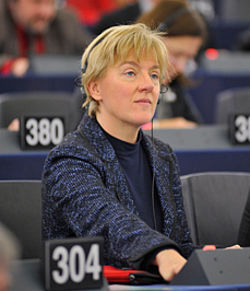SDGs One year on - where is the EU?

The Sustainable Development Goals (SDGs) were adopted a year ago in New York with the aim of leaving no-one behind and eliminating poverty by 2030. There is also a strong overlap between the SDGs and the UN Convention on the Rights of Persons with Disabilities (CRPD), the implementation of which must go hand in hand with that of the SDGs. Governments of Member States and the EU Commission are in the process of designing their strategies for getting to 2030. This article is written by Linda McAvan, Labour MEP for Yorkshire and the Humber, Chair of Committee on Development.

CBM
The Sustainable Development Goals (SDGs) were adopted a year ago in New York with the aim of leaving no-one behind and eliminating poverty by 2030. The SDGs contained several goals with links to improving the rights of persons with disabilities - recognising that disability is both a cause and a consequence of poverty and needs to be addressed as part of international development efforts. There is also a strong overlap between the SDGs and the UN Convention on the Rights of Persons with Disabilities (CRPD), the implementation of which must go hand in hand with that of the SDGs.
One year on, we are only just starting the process of turning the promises made in New York into reality. Governments of Member States and the EU Commission are in the process of designing their strategies for getting to 2030. In July, Development Commissioner Neven Mimica presented some aspects of the EU’s planning to the UN at the High Level Political Forum on Sustainable Development
As Mimica outlined, the EU has two broad focuses for meeting the SDGs: redefining its development strategy through creating a new Consensus on Development and integrating SDG targets into its internal policies. Domestically, the EU already has certain policies that will contribute to meeting the SDGs, ranging from the re-launched Circular Economy package, to the mainstreaming of gender in EU policy through gender action plans. Vice-President Timmermans is currently conducting an analysis of where the EU stands in relation to the SDGs which should be presented in the autumn. This exercise should identify where the gaps are in the current policy framework, it will then be up to the Commission to present a comprehensive plan for addressing them, which should refocus all EU policy towards meeting SDG targets - probably linked to the replacement of the Europe 2020 strategy. For external policy, deliberations are already at an advanced stage on a new Consensus on Development with a public consultation having taken place over the summer and a proposal due in November.
The Consensus will represent the overarching framework of how the EU wants to work during the next decade and more. This new policy framework will help set the tone for how the EU deals with the changing development landscape - with responses to migration and security challenges as well as new funding models, differentiation between low and middle income countries and better development effectiveness all currently under discussion.
The key points the Commission should be looking at in building a new Consensus are distilling the value that the original Consensus brought, setting out how the world has changed since 2005 and why a new Consensus is necessary and then outlining how to address these changes whilst maintaining the value of the original.
As well as these issues, the Consensus will be an important staging post for the mainstreaming of disability in EU development policy. The EU has done a lot to improve disabled rights at home, and its development policy should reflect the same commitment. As the development committee noted in its opinion on implementation of the CRPD, all EU policy should be consistent with the UN convention and we will be looking for a reference to mainstreaming disability issues to be in the new Consensus on Development.
This is a time of great opportunity to shape EU development policy for the near future, but it is also a time of challenges. The decision of the UK to leave the European Union, Brexit, is one of those challenges.
As a UK Labour politician, I campaigned hard against Brexit, but the people have spoken and at this stage we have to accept the result. This is going to have far reaching consequences for much of EU policy and development is no exception. The UK has been a strong advocate for development policy within the EU. It is the largest donor to the EU aid budget, the only large EU member with a development minister who is a Secretary of State and it was the chief architect behind the original Consensus on Development.
At this stage no-one knows what Brexit will mean in practice, not even the UK government. In terms of development policy, we want to avoid the UK’s exit causing disruption to project funding - budgetary certainty will be important if we want to prevent a funding freeze. We also will push the UK to continue working as closely as possible with its EU partners to maximise their combined influence and achieve their common development goals.
Brexit is certain to be an ever-present in political discussion over the coming years, but it shouldn’t be used as an excuse by either the UK or the EU to reduce their ambitions in terms of development policy. Despite the political situation, it will be important for all actors to make sure that policymakers’ attention remains on realising the commitments they made to the SDGs last year in New York.